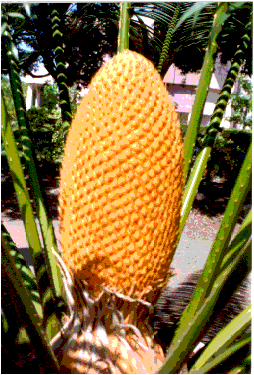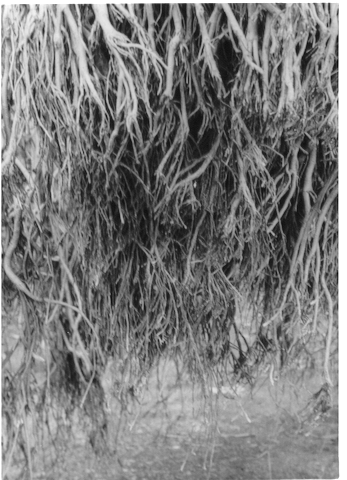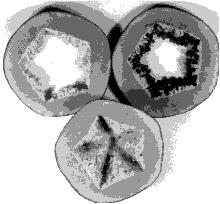![]()
Parastichy pair(13:21) of CYCAS REVOLUTA (male) florets

The branching (bifurcating) structure of roots,shoots, veins on leaves of plants, etc., have similarity in form to branched lightning strokes, tributaries of rivers, physiological networks of blood vessels, nerves and ducts in lungs, heart, liver, kidney, brain etc. Such seemingly complex network structure is associated with exquisitely ordered beautiful patterns exhibited in flowers and arrangement of leaves in the plant kingdom.

The identification of physical mechanism for the spontaneous generation of mathematically precise, robust spatial pattern formation in plants will have direct applications in other areas such as in physiology and medicine.
The botanical elements which constitute plants are branches, leaves, petals, stamens, sepals, florets, etc. These plant elements begin their existence as primordia in the neighbourhood of the undifferentiated shoot apex (extremity). Extensive observations in botany show that in more than 90% of the plants studied worldwide primordia emerge as protuberances at locations such that the angle phi subtended at the apical center by two successive primordia is equal to the golden angle {2*pie(1-(1/tau))) where tau is the golden mean and is approximately equal to 137.5 degrees. The golden mean is the most irrational number and is associated with the Fibonacci mathematical sequence 1, 1, 2, 3, 5, 8, ...... where each term is the sum of the two previous terms and the ratio of each term to the previous term approaches the golden mean approximately equal to 1.618. The golden mean is the most irrational number in the sense that rational approximations converge very slowly to tau as compared to other irrational numbers. Irrational numbers are numbers such as square root of 2 which has an infinite number of non-periodic decimals. Rational approximations such as p/q where p and q are integers are used to represent irrational numbers. The golden mean had a special significance in ancient cultures. The significance of the golden mean throughout recorded history in science, culture and religion has been discussed (Hargittai and Pickover, 1992; Hargittai, 1992 References). The surprisingly precise geometrical placement of plant primordia results in the observed phyllotactic patterns, namely , the familiar spiral patterns found in the arrangement of leaves on a stem, in florets of composite flowers, the patterns of scale on pineapple and pinecone, etc. The word phyllotaxis is of Greek origin (phyllon, leaf and taxis, arrangement) and literally means the study of the disposition of leaves on the stem. Phyllotaxis, in a broader sense now includes the study of arrangement of all plant elements which originate as primordia.
The mathematical precision underlying placement of primordia is intrinsic to plant growth processes throughout the plant kingdom. Therefore, growth processes are governed by universal laws independent of plant species, related plant genetics, climate and geographical location. Botanists, physicists and mathematicians alike have been fascinated by such universal rhythms governing plant growth and the field of phyllotaxis has a long history of more than 150 years. A comprehensive review of phyllotaxis has been given by Jean (1984; 1994)( References).
The placement of successive primordia with a constant divergence angle equal to the golden angle is associated with the following observed ergonomic characteristics of plant growth : (1) The spacing of leaves on shoot is such that no two successive leaves are placed exactly one over the other and all the leaves get maximum exposure to sunlight for photosynthesis purpose. (2) With formation of flower on the shoot, upward growth gives place to lateral (planar) growth of primordia. These primordia develop into florets (small flowers) on the capitulum in beautifully arranged counter-rotating spiral pairs called "parastichy pairs". The Fibonacci numbers, namely, 1, 1, 2, 3, 5, 8, 13, 21 .... etc., underlying the golden angle are exhibited by the parastichy pairs e.g., 5 spirals in the clock-wise (anti clock-wise) direction are always accompanied by 8 spirals in the counterclock-wise (clock wise) direction. (3) The beautiful patterns of the parastichy pairs also incorporate maximum packing efficiency of seeds which develop from florets . (4) The golden angle ensures selfsimilarity in geometrical shape (Jean, 1994), i.e. identical form for all sizes of capituli of a particular species, e.g. sunflower, daisy, etc.
1.2 Golden mean and selfsimilar, fractal geometrical
structures in nature
Animate and inanimate structures in nature exhibit selfsimilarity in geometrical shape (Stevens, 1974; Freeman, 1987; Jean, 1984 References), i.e. parts resemble the whole object in shape. The most fundamental selfsimilar structure is the forking (bifurcating) structure (Jean, 1994) of tree branches, tree roots, river tributaries, branched lightning, etc. The hierarchy of complex branching structures occupy only a part (fraction) of 3-dimensional space or a fraction of 2-dimensional space in a 2-dimensional projection, and therefore they belong to the recently identified (Mandelbrot, 1977) category of fractal objects. The complex branching architecture is a selfsimilar fractal since branching occurs on all scales (sizes) and forms the geometrical shape of the whole object. Selfsimilar branching structure is seen in (1) roots of the banyan tree (ficus religiosa or indica) (2) veins on a leaf and (3) branches of a shrub. The substantial identity of the fractal architecture underlying leaf and branch was recognized more than three centuries ago (Arbor, 1950). The universal symmetry of selfsimilarity underlies apparently irregular complex structures in nature (Schroeder, 1991 References). The study of fractals now belongs to the new field nonlinear dynamics and chaos, a multidisciplinary area of intensive research in all fields of science in recent years (since 1980s). Jean (1994) gives examples of phyllotaxislike patterns in chemical, physical and biological systems in nature. Selfsimilar structures incorporate the noble numbers, i.e. numbers which are functions of the golden mean and are characterized by fivefold symmetry of the pentagon and dodecahedron. For example, the ratio of the length of the diagonal to the side in a regular pentagon is equal to the golden ratio . Selfsimilar spiral structures such as on the shell of the very old mollusk called Nautilus pompilius (Jean, 1994) incorporate the golden mean in their radial growth. The commonly found shapes in nature are the helix and the dodecahedron (Stoddart, 1988) which are signatures of selfsimilarity underlying Fibonacci numbers. Representative examples of fivefold symmetry in the vegetable kingdom are seen in the cross sections of okra, papaya and the Fibonacci spiral pairs are seen in the arrangement of florets in the cycas revoluta flower (male)(shown above).

Selfsimilar growth, ubiquitous to nature (living and nonliving), is therefore governed by universal dynamical laws which are independent of the exact details (chemical, physical, physiological, electrical etc.) of the dynamical system, i.e., a system which evolves with time.